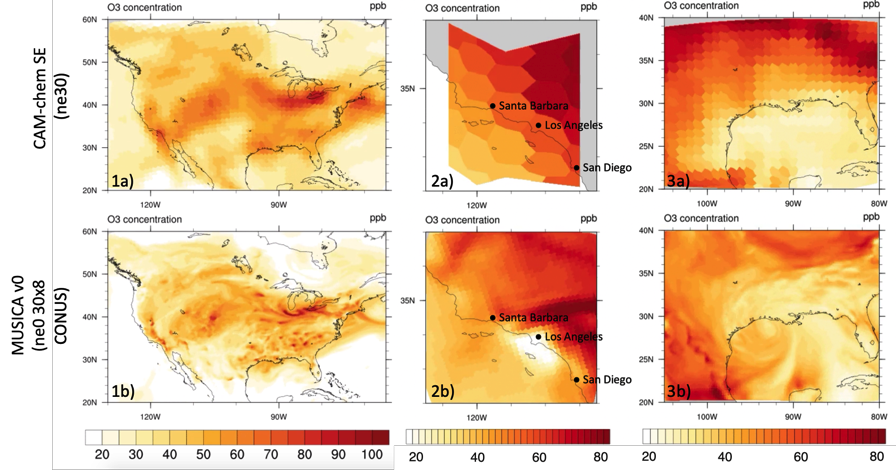MUSICA Version 0 Based on CAM-Chem
ACOM has made significant progress in developing the Multiscale Infrastructure for Chemistry and Aerosols (MUSICA). MUSICA will be an NCAR-led next generation community infrastructure for studying atmospheric composition across all relevant scales using a unified and modular approach and making use of the Model Independent Chemistry Module described below. We envision configurations of MUSICA capable of simulating the globe to capture large-scale phenomena while still resolving chemistry and physics at local scales relevant to impact assessment and decision-making. The infrastructure will enable us to address frontier science questions related to the interactions between atmospheric chemistry and weather and climate that span multiple scales, while at the same time accounting for feedbacks between all components of the Earth System. Example frontier science questions include investigating the impact of local air quality on continental and global regions and, conversely, examining the impact of distant sources or global phenomenon (e.g. ENSO) on local air quality.
MUSICA is being developed with and for the atmospheric sciences community. In May 2019, ACOM hosted a Kickoff Meeting for MUSICA with over 60 participants from 23 institutions (including NCAR). The Kickoff Meeting established working groups for MUSICA, that are composed of university, government, and NCAR researchers. The working groups direct development in the areas of model architecture, emissions and deposition, chemical mechanism schemes, aerosol representation and processes, physics and sub-scale transport and processes, upper atmosphere processes, and evaluation and data assimilation. Leaders of these working groups have developed an initial description of their topic, the expected development for MUSICA, and challenges and scientific gains expected from MUSICA studies that are being merged into a publication on the vision of MUSICA.
ACOM scientists have created a regionally refined version of the CAM-chem global chemistry climate model (called MUSICA version 0). This model development takes advantage of recent advancements in the Community Atmosphere Model (CAM) that uses the Spectral Element dynamical core for an unstructured grid mesh based on a cubed sphere, which now allows for regional refinement (CAM SE RR). To create MUSICAv0, an emissions tool was built to regrid emission inventories from the latitude-longitude and point source emissions datasets onto the unstructured model grid mesh of CAM SE RR. This emissions tool is being applied to both anthropogenic and fire emissions. Initial MUSICAv0 simulations use a grid mesh with global horizontal grid spacing of 1˚ that refines to 0.125˚ (~14km) over the conterminous U.S. Simulation output is being evaluated with observations gathered in several field campaigns during 2013 (DISCOVER-AQ-CA, DISCOVER-AQ-TX, SAS, SEAC4RS, SOAS, and SENEX) and U.S. EPA CASTNET and AirData air quality monitoring data. Preliminary results from these simulations show that ozone and ozone precursors are generally improved at finer horizontal resolution (14 km) compared to both the field campaign and monitoring data. Improved horizontal resolution in MUSICA is important for capturing ozone plumes from point sources such as fires and power plants throughout CONUS (Figure 1a), simulating ozone at human exposure relevant scales (Figure 1b), and capturing transport of pollutants from tropical storms (Figure 1c). The combination of these model changes also result in a 20% increase in modeled population-weighted PM2.5 over the US, with larger differences in specific regions, i.e. state or EPA-region level, that will have significant impacts on the estimated burden of disease related to ambient air pollution.

Figure 1. Comparison of surface ozone concentrations between the baseline model simulation (CAM-chem SE at ne30 resolution) and MUSICA v0 with refinement over CONUS. Panels 1a and 1b show the refined domain and highlight the impacts of point source emissions, i.e. biomass burning and power plants. Panels 2a and 2b show the model reaching exposure-relevant scales over Southern California with the impacts of model-driven ozone removal over Los Angeles. Panels 3a and 3b show the initiation of a tropical storm and the related transport of pollutants. Click for larger image.
Contact
Please direct questions/comments about this page to:
Carl Drews
NSF NCAR | Research IT | ACOM